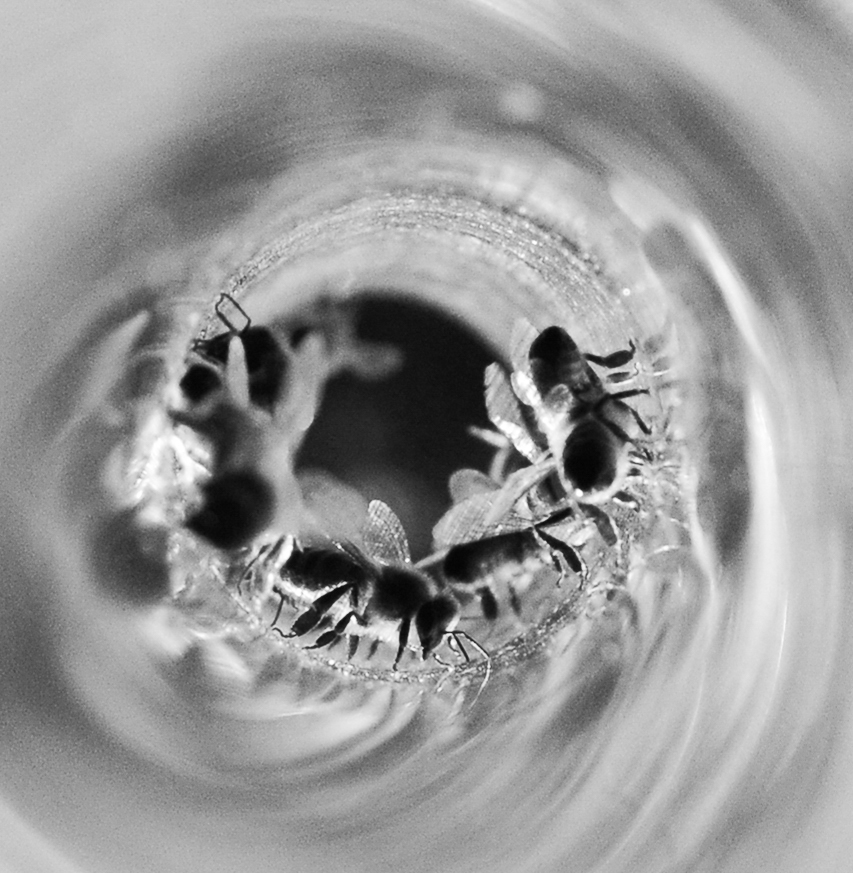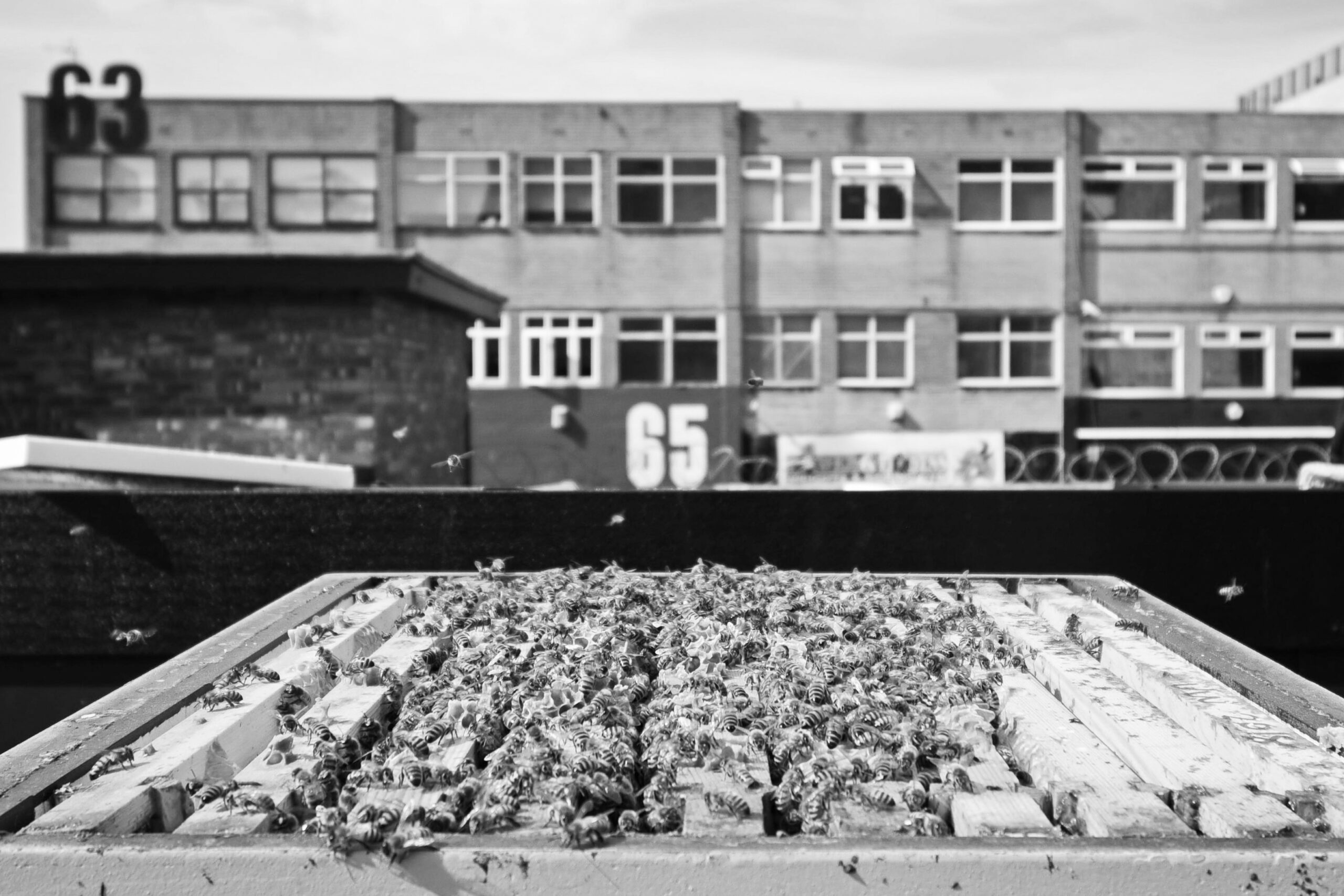Community collaborators are buzzin’ for honey!
We’ve had a weird half of the year locally and globally but amid this crazy time, three-city independents are getting a bit of a buzz.
Dead Pigeon Gallery, The Tapestry and B 4 Biodiversity CIC have collaborated in the past and have recently come together again over summer to deliver some special golden prizes.
During summer 2020, the first-ever harvest of golden honey was spun and jarred up by apiarist, Andrea Ku. The bees have been on the Tapestry roof for three summers now.
The idea of bees on the Tapestry roof came about in September 2017, when the inaugural Dead Pigeon Gallery exhibition took place. Founder, Jayne Lawless, set up DPG in 2017.
DPG was set up in response to the lack of exhibition space and opportunities for artists in Liverpool. Jayne decided on a DIY approach in looking for a space to exhibit that was outside of the traditional gallery setting.
So why call it Dead Pigeon Gallery? On the first few visits to space on Kempston Street, the DPG artists were greeted by many pigeons, some alive, some dead! It led to a throwaway comment about it being a ‘dead pigeon gallery’ and so the name stuck.
"The honey will have a very unique taste to it – it will taste of the local landscape where the bees have foraged."
While Jayne was an artist in residence with a project called Coming Home, she was on the look-out for somewhere to showcase her work made in response to that time.
She met Jason Abbott along the way who happened to be at the start of his journey in redeveloping the former printers now known as The Tapestry. The building had been in his family for many years and was semi-derelict. The artists moved in alongside the builders which made for a very active and dynamic site.
The exhibition theme of ‘home’ came about via Coming Home, a project set up to research and develop new ways of redeveloping existing empty houses in the city.
The bees were a part of the exhibition within a glass-fronted observation hive. Their entrance/exit was through a long clear tube where the bees could fly to and from the gallery. They were bringing home pollen and nectar, from local green space such as Everton Park.

Bees in tube
The theme carried through to show the bees preparing their home for the coming cold months, so ensuring the last of the nectar was collected as its nectar which is converted into honey which the bees need to live on in winter.
Artist and beekeeper, Andrea Ku from B 4 Biodiversity, went on to carry on the bee element at the Tapestry and installed two colourful beehives on the roof in the summer of 2018. After two years, four queens and hundreds of thousands of bees later, there is a little bit of honey available to harvest still leaving more than enough for the bees to see through the rest of the year and into 2021.
The two bee colonies have got bigger in number and size over the last two years. The bees main areas of forage are the wildflowers and trees on Islington and Everton Park. The honey will have a very unique taste to it – it will taste of the local landscape where the bees have foraged.

Apiary on the Tapestry roof
The Tapestry buildings had been where Jason Abbott’s father had grown the successful Taylors Screenprinters before its closure around 2000. His role since has been to oversee the renovation, reactivation and general running of the spaces along with his small team of the old run-down set of warehouses that became The Tapestry.
He is also currently Chair of the Fabric District CIC which is the area advocacy group for trying to ensure a Business and residential community thrive whilst encouraging a good mix of uses in developments and public realm.
The Tapestry is now a mixed-use creative hub with a unique workspace that houses communities from the tech, maker and fashion worlds along with two bars and three event spaces. They are also working on plans for an art garden to open in 2021.
For Jason, the bees are really important to ensure we cherish and encourage the local bee diversity when and where we can. Fabric District has been identified by Mersey Forest as having the lowest green infrastructure in the city and they are trying to change that, with new trees planted on Stafford St in the next few months. This will hopefully be the start of a greener and more biodiverse future for the area.
When Jason met Andrea, he was fascinated that bees could form part of a gallery and admits his lack of knowledge in the arts where Jayne and the other DPG crew were gradually changing.
‘We first spoke about the bees being on the roof as a continued art plan with a camera in the hive being screened on our big gable wall, I still hold this idea as one to do as part of the Tapestry’s plans,” he said.
“Hopefully there will be more spaces across the fabric where the bees can live and forage as the number of flat roofs allows opportunities’’
Having never been involved in anything arty since leaving school, Jason was unsure what was coming but the vibe was right. He and the artists had a laugh along the way which took some of the stress away from the construction going on at the same time.
‘’I remember the opening night clearly and seeing my dad’s face with all the life and activity in his old place,” Jason continued.
“The turnout was amazing given it was still seen as a no go and a red light district by many. DPG sparked something that has taken hold in the area and has led to two arts festivals (would have been three but for COVID) and the street art and culture across the district in large part are a continuation of what happened with DPG and the “screw it lets do it” attitude. Long live the DPG!’’

Sign up to Scottie Press for all the latest local news and events.
Sign
Up
Sign up to Scottie Press for all the latest local news and events.

